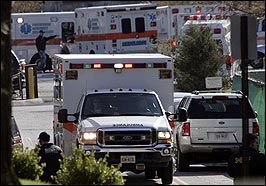The military has a saying, “Prior planning prevents poor performance.” However, in our world we are often too busy keeping daily operations running to find time to preplan for a mass casualty incident.
A MCI may be a once in a career event, and that mindset makes it easy to put the planning and preparation for one on the back burner. Hopefully, this article will make you move your plans forward.
Having served in the role of a multi-casualty branch director of a MCI with about 100 patients, there are several things that I’ve learned that may make things run smoother for you.
If you fail to plan and prepare, you will face problems. The only place more uncomfortable will be during the post incident review when every “expert” sniper in the region will have you in their crosshairs, questioning every action you took, as well as failures on your part to prepare.
 AP Photo/Steve Helber An ambulance leaves the site of a shooting on the campus of Virginia Tech in Blacksburg, Va., April 16, 2007. A gunman massacred 32 people at Virginia Tech in the deadliest shooting rampage in U.S. history. |
MCI complexities
Every system needs to have the capacity to manage a MCI. These incidents can happen at any time, and usually when you least expect it. The definition of an MCI will vary as to the capacity and resources of your system. What may be considered a MCI in a small rural community may be a routine incident in a large one. However, the strategy and tactics are basically the same.
A MCI can be as varied as your imagination. It can be defined as any incident with more patients than you can manage. Not having the available resources or person-power puts you into a MCI situation. Even if your community has a wealth of resources, when those resources are expended or you’re unable to reach the scene, you are entering the MCI zone. Such incidents can include fire, hazmat, floodwater, riots and collapse.
Our MCI was a chemical release in a large meatpacking plant, where workers spoke more than 60 different languages. The incident happened over the lunch period, so interpreters and supervisors did not have full accountability of workers, and communication was very limited. One last spin — it occurred in the winter. Remember, a MCI will never happen where and when you are ready.
National Incident Management System
I’m assuming in this article that the National Incident Management System is used and embraced by your system. The use of NIMS ensures that everyone is talking the same talk, and as outside agencies respond to your incident, they will know their roles because NIMS is a national program.
If you feel you do not need to use NIMS, it is time to retire or leave and give your organization the opportunity to catch up with the rest of the world. There is no excuse for not implementing NIMS in your area of responsibility.
In some incidents, there may be multiple emergencies occurring so it is critical that NIMS is used by the Incident Commander, especially when there are several hazards present. NIMS allows the Incident Commander to easily break any incident into manageable portions.
With a MCI involving up to 25 patients, the basic key strategic considerations will be triage, treatment and transport. With larger incidents, more branches may be needed to facilitate more transportation as you add communications with additional ambulance agencies, hospitals and the possibility of air operations.
The seven things at the strategic level that the Incident Commander needs to consider are:
1. Determining the appropriate strategy for the incident. This includes the “big picture” of what needs to be done. The Incident Commander is the person in charge, and ultimately has the responsibility for the incident.
2. Establishing overall incident objectives, which will vary depending on the incident. This gives a “game plan” to the incident. An example of objectives may be to account for patients and their transportation, decontamination, triage and treatment.
3. Setting priorities for the incident and creating benchmarks for how you want the incident to progress. Part of an Incident Commander’s initial organizational priorities should be to designate a:
-
- Triage unit leader
- Treatment unit leader
- Patient transportation group supervisor
- Ground ambulance coordinator
4. Developing an incident action plan, and remembering to communicate it. This is one area that can break down very easily due to various factors including failure to communicate with other agencies.
5. Obtaining and assigning resources. Calling resources early to an incident allows you to assign them quickly and get ahead of any upcoming problems. A MCI is a time to “go ugly early,” and plan for the worst case scenario. That means to call and move resources to the incident before you need them.
6. Initiating a unified command with other agencies when needed, which will help bring all the decision makers into the loop. This will lessen the chance of agencies not knowing critical information and also allows decisions and actions to be implemented more quickly.
7. Since a MCI may be a rare event, you may not remember the organizational templates. Develop them before the time comes when you actually need them. These can be simple “cheat-sheets” you can make, and should follow NIMS and be easily referable.
Successful responses to a MCI will be determined in large part on how well the Incident Commander is able to effectively plan for an initial command of the incident. Being aware of the required overall strategic goals and how to implement them will move you in the right direction to handle a — hopefully — once a career event.











